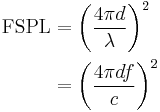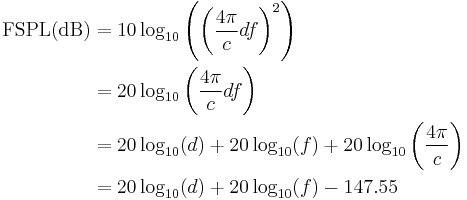Free-space path loss
In telecommunication, free-space path loss (FSPL) is the loss in signal strength of an electromagnetic wave that would result from a line-of-sight path through free space (usually air), with no obstacles nearby to cause reflection or diffraction. It does not include factors such as the gain of the antennas used at the transmitter and receiver, nor any loss associated with hardware imperfections. A discussion of these losses may be found in the article on link budget.
Contents |
Free-space path loss formula
Free-space path loss is proportional to the square of the distance between the transmitter and receiver, and also proportional to the square of the frequency of the radio signal.
The equation for FSPL is
where:
 is the signal wavelength (in metres),
is the signal wavelength (in metres), is the signal frequency (in hertz),
is the signal frequency (in hertz), is the distance from the transmitter (in metres),
is the distance from the transmitter (in metres), is the speed of light in a vacuum, 2.99792458 × 108 metres per second.
is the speed of light in a vacuum, 2.99792458 × 108 metres per second.
This equation is only accurate in the far field where spherical spreading can be assumed; it does not hold close to the transmitter.
Free-space path loss in decibels
A convenient way to express FSPL is in terms of dB:
where the units are as before.
For typical radio applications, it is common to find  measured in units of MHz and
measured in units of MHz and  in km, in which case the FSPL equation becomes
in km, in which case the FSPL equation becomes
For  in meters and megahertz, respectively, the constant becomes
in meters and megahertz, respectively, the constant becomes  .
.
Physical explanation
The FSPL expression above often leads to the erroneous belief that free space attenuates an electromagnetic wave according to its frequency. This is not the case, as there is no physical mechanism that could cause this.
The expression for FSPL actually encapsulates two effects. Firstly, the spreading out of electromagnetic energy in free space is determined by the inverse square law, i.e.
where:
 is the power per unit area or power spatial density (in watts per metre-squared) at distance
is the power per unit area or power spatial density (in watts per metre-squared) at distance  ,
, is the total power transmitted (in watts).
is the total power transmitted (in watts).
Note that this is not a frequency-dependent effect.
The second effect is that of the receiving antenna's aperture, which describes how well an antenna can pick up power from an incoming electromagnetic wave. For an isotropic antenna, this is given by
where  is the received power. Note that this is entirely dependent on wavelength, which is how the frequency-dependent behaviour arises.
is the received power. Note that this is entirely dependent on wavelength, which is how the frequency-dependent behaviour arises.
The total loss is given by the ratio
which can be found by combining the previous two expressions.
See also
Further reading
- C.A. Balanis, "Antenna Theory", 2003, John Wiley and Sons Inc.
- Andrea J. Goldsmith, PhD Thesis
External references
- Derivation of the dB version of the Path Loss Equation
- Propagation Models Chapter on Free Space Propagation





